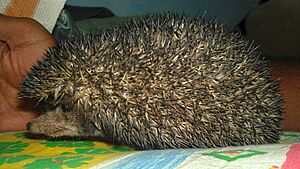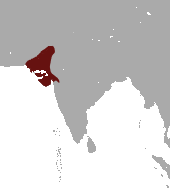Indian hedgehog facts for kids
Quick facts for kids Indian hedgehog |
|
|---|---|
 |
|
| Conservation status | |
| Scientific classification | |
| Genus: |
Paraechinus
|
| Species: |
micropus
|
 |
|
| Indian hedgehog range | |
The Indian hedgehog (Paraechinus micropus) is a small, spiky mammal. It is a type of hedgehog that lives in India and Pakistan. You can mostly find it in sandy desert areas. But it can also live in other places.
Contents
About the Indian Hedgehog
What Does an Indian Hedgehog Look Like?
The Indian hedgehog looks a bit like the long-eared hedgehog. They both have a similar lifestyle. This hedgehog is known for its unique "masked" face. It has dark fur with a white top, a bit like a raccoon.
These hedgehogs are quite small. An adult male usually weighs about 435 grams. An adult female is a bit lighter, weighing around 312 grams. They can move pretty fast!
Their fur is mostly brown. You might see some lighter shades of brown too. Their tail is very short, only about 2 to 4 centimeters long. They have a sturdy body with a short head and a long nose. Their eyes are small and dark, and their ears are fairly large. Their legs are gray-brown. Each foot has five toes with small but strong claws.
Protected Status
Indian hedgehogs are important animals. They are protected by law in India. This means it is against the law to harm them. They are listed under Schedule IV of the Wildlife Protection Act (1972).
Indian Hedgehog Behavior
What Do Indian Hedgehogs Eat?
Indian hedgehogs are part of the Erinaceidae family. This means they eat many different things. Their diet includes insects, especially beetles. They also enjoy worms, slugs, frogs, and toads. Sometimes, they eat bird eggs, snakes, and even scorpions!
How Do They Survive?
Indian hedgehogs do not hibernate like some other animals. But they can slow down their body's activities. This helps them save energy when there isn't much food around.
When danger is near, the Indian hedgehog has a special trick. It rolls up into a tight ball. The top part of its body is covered in sharp spines. These spines protect it from animals that want to eat it.
Where Do They Live?
These hedgehogs are good at digging. They can dig burrows that are about 45 centimeters long. They use these burrows to sleep in. They also hide in them to stay safe from danger. If they find an empty burrow, they will often move in!
Self-Anointing Behavior
Like all hedgehogs, Indian hedgehogs do something called self-anointing. This is a very interesting behavior. After they taste or smell something new, they spread their own saliva onto their spines and fur. Scientists are not completely sure why they do this. This behavior happens in both male and female hedgehogs. It can happen at any age and at any time of the year.
Reproduction and Life Cycle
Male and female Indian hedgehogs only meet to have babies. After breeding, the female hedgehog raises her young alone. She does not get help from the male. A female can give birth to up to three baby hedgehogs at a time.
Who Hunts Indian Hedgehogs?
Indian hedgehogs have natural enemies. These include foxes and Indian grey mongooses (Herpestes edwardsi). Rock-horned owls (Bubo bubo turcomanus) also hunt them. These predators need to be very fast. They must catch the hedgehog before it can curl up into its spiky ball for protection.


